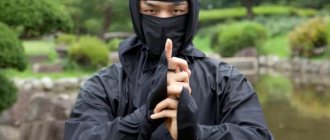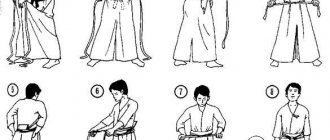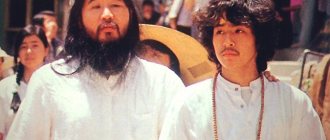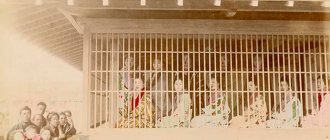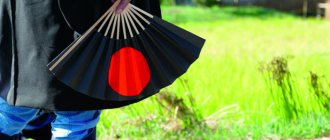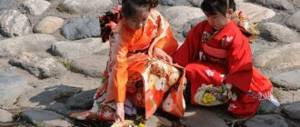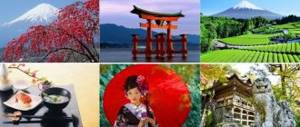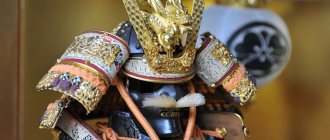Basics of ninjutsu teachings
The main principle of ninjutsu is the impossibility of achieving a state of complete safety. Any action gives rise to reaction. The stronger the blow to the natural balance, the more dangerous and destructive the response will be. The solution to the problem lies in understanding the laws of the universe and the ability to minimize the negative consequences of interference in world harmony.
The teaching is based on three groups of skills that, forming a coherent system, allowed ninja warriors to withstand any threat:
- The first group of skills relates to the ability to make the most of environmental conditions to successfully complete a mission. Ninjas had to learn to recognize tracks, become elusive to the enemy, avoid traps and set up ambushes. To do this, they needed to conquer all 5 elements - Ti (Earth), Sui (Water), Ka (Fire), Fu (Air) and Ku (Emptiness, or the fundamental principle of everything).
- The second group of skills ensures success in combat with the enemy. This includes the following subsections:
- Taijutsu - skills of perfect body control;
- Bu-jutsu - mastering weapons.
- The third group of skills is devoted to the spiritual practice of Nimpo-mikkyo, with the help of which the internal resources of the body are mobilized and the fundamental principle of the world is comprehended - Ku, or Emptiness.
Ninjutsu fighting techniques
Japanese historian A.M. Gorbylev believes that the ninja training system was based on the hand-to-hand combat technique of jujutsu and the art of handling weapons called budo. At the same time, samurai fighting styles were very different from the bu-jutsu used by ninjas. The main differences between spy martial arts are as follows:
- a greater number of strikes compared to samurai jujutsu;
- frequent use of choking techniques as they are more silent;
- increased attention to battles in confined spaces (in bushes, bamboo thickets, cramped rooms with low ceilings, etc.). Fighting in a limited area forced warriors to use short strikes and shortened versions of weapons. Thus, ninja swords were much shorter than samurai swords.
- preference was given to surprise attacks from behind, under the cover of darkness or from ambush;
- more time was spent on practicing techniques to disorient the enemy, which allowed the declassified spy to escape unnoticed.
To break away from his pursuer, the ninja warrior fell sharply under the feet of the enemy, and he flew over the spy, losing the ability to navigate in space. When attacked from the side, the scout suddenly braked, letting the enemy pass forward and striking with a sword from the back.
A.M. Gorbylev believes that the art of ninjutsu in general involved the study of surprise attack techniques. At the same time, the warriors avoided open battles, trying to win before they were noticed by the enemy.
Shurikens are terrible weapons
Everyone knows that ninjas love shurikens—throwing projectiles that resemble stars. In films, shinobi throw them with such force that they break through walls, pierce through enemies in modern body armor, and even amputate limbs of opponents! This is what the secret techniques of ninjutsu mean.
In fact, even an extremely strong person cannot throw a shuriken so as to cut off an enemy’s leg.
Unless, of course, he has a prosthetic arm with a built-in spring shuriken thrower, like the main character of the game Sekiro: Shadows Die Twice. But it’s unlikely that real shinobi had such technology.
Screenshot from the game Sekiro: Shadows Die Twice
Shurikens have never been the main weapon of ninjas, since it is very difficult to kill a person with such a thing. More often they were used by Classical Weaponry of Japan: Special Weapons and Tactics of the Martial Arts to disorient the enemy: a couple of them fly into your face, you instinctively turn away to save your eyes, and receive a kusari-kama to the skull.
In addition, shurikens have very mediocre ballistics, so they were thrown on the principle of “just hope you hit somewhere.” They were also lubricated by Secrets of the Samurai; A Survey of the Martial Arts of Feudal Japan, Black Belt was poisoned or covered with animal feces, or even with one’s own feces, to increase the chance of blood poisoning in the enemy when wounded. By the way, doing the same thing, for example, with bamboo spears, was also not forbidden.
Often, shurikens would also be buried in the ground for a period of time so that their surface would be covered with Secrets of the Samurai; A Survey of the Martial Arts of Feudal Japan by the anaerobic bacterium Clostridium tetani, which causes tetanus. And then even a scratch from such a shell became dangerous.
Shurikens were not the only ranged weapons. Ninjas also shot Ninja AD 1460–1650 from bows, muskets and arquebuses. They also used bombs and laid mines.
In addition, shurikens did not necessarily look like stars. These could be simply sharpened thin knives, or round throwing missiles, or something similar to coins or chopsticks - such things could easily be carried past the guards.
Photo: Rustedshuriken / Wikimedia Commons
And by the way, shurikens were used in Secrets of the Samurai; A Survey of the Martial Arts of Feudal Japan, not only ninjas, but also samurai - they saw nothing shameful in pelting the enemy with sharp things smeared with all sorts of dirty tricks.
Ninja outfit
The ninja camouflage suit was called shinobi shozoku. It consisted of the following elements:
- uvagi (jackets with secret pockets);
- dojime (belts with an eight-layer iron chain in the core);
- iga-bakama (pants with a secret pocket);
- dzukin (mask that hides the face);
- tekko (overlays on the back of the hand);
- kyakhan or asimaki (leg wraps in which ninjas hid weapons);
- tabi (shoe-socks with a separate big toe);
- waraji (extremely durable sandals);
- uvappari (an outer jacket that could be used as a parachute);
- nagabukuro (“backpack” ninja).
The variable robe was called “kawari-gomono” and was a type of uwappari jacket. The ninja costume was complemented by a straw amigas hat.
The armor of spy warriors was divided into two types:
- full chain mail armor, or kusari-katabira;
- light armor made of leather and iron plates - tatami-gusoku.
Shields provided protection for the warrior:
- round tetsu no kame;
- thick leather shield nerukawa-ita.
The above elements provided the proper protection and attire for the spy warrior.
Ninjas wore black
Still from the film “Ninja 2”
In modern culture, ninjas are such psychos in black pajamas and balaclavas, waving their arms and shouting “ki-i-i-ya!” But real shinobi, naturally, did not dress like that.
A typical ninja, going on a mission, most likely looked Ninja AD 1460–1650 like an ordinary peasant: he dressed in a worn Japanese gappa cape, covering his face with a fabric zukin hood. Such a person will not arouse suspicion among the city guards - how many ragamuffins are hanging around?
There is absolutely no need to put on a black tight suit and climb the walls when you can pretend to be another farmhand and calmly enter the gate. Cameras with facial identification had not yet been invented.
Photo: Kusakabe Kimbei / Museum of Photographic Arts Collections / Wikimedia Commons
The Enemy Within also disguised ninjas as priests, artists, soothsayers, merchants, ronins, monks, and the most arrogant ones could pass themselves off as a noble samurai.
Most of all, shinobi loved the attire of the komuso monks, because they wore Ninja AD 1460–1650 basket hats on their heads, completely hiding their faces. In addition, under their loose clothing it was easy to hide weapons Handbook to Life in Medieval and Early Modern Japan, The ninja: ancient shadow warriors of Japan. Pretending to be a komuso playing the flute and begging in the square, one could sit for hours near the desired building and spy without arousing suspicion.
Photo: Tarourashima/Wikimedia Commons
And even if a shinobi wanted to sneak somewhere, hiding in the shadows, he would not dress in black, since this color is too noticeable. He would have preferred something gray or dark red, better than the Ninja AD 1460–1650 to hide in the twilight.
The black ninja suit, now popular, originated from the Japanese bunraku theater, where it was worn by backstage workers to avoid being noticed against a dark background.
Weapons of medieval spies
The weapons used by ninja warriors can be divided into several categories:
- Firearms, or kaki, could be matchlock, flintlock, blowgun, and secret, that is, disguised as various things. For example, guns were disguised as a Wakizashi sword, a brush case, and a smoking pipe.
- Harinuki-jutsu cannons, unlike wooden mokuho, had several layers of paper coating.
- Fire arrows, hollow bamboo tubes stuffed with an explosive mixture, and burning shurikens were used as incendiaries.
- Often all kinds of poisons were used to destroy the enemy and leave no traces.
- In combat operations, ninjas used edged weapons:
- swords (ninja, shinobi-gatana);
- knives (tanto);
- spears (shibaki-yari);
- sickle-shaped spears (kamayari);
- axes (it);
- small halberds (konaginata);
- hidden weapons disguised as other objects (shikomi-zue);
- half-sickles with a weight on a chain - kusari-kama.
- Throwing weapons were popular among ninjas:
- half bow (hankyu) and arrows (yumiya);
- various types of shuriken;
- poisoned fukian arrows, which were fired from a blowgun;
- utine - short arrows with a heavy tip, etc.
In battle, warriors also used fighting poles, clubs, ropes and chains.
Ninjas armed themselves with a special sword - ninjato
Photo: Danny Choo / Flickr
When we say “samurai,” we imagine a mustachioed man with a shaved forehead and a curved katana. When we hear “ninja,” we picture in our heads the image of a warrior in black wearing a short straight sword. People who think they understand Japanese culture will call this weapon "ninjato", or "shinobigatana" - the sword of a shinobi. This sword has a short, straight Art of the Ninja blade and a square tsuba.
But there is no evidence that ninjato actually existed during the time of real shinobi. This is a remake of Japan: its history, traditions, and religions. With the narrative of a visit in 1879, Stage Combat: Fisticuffs, Stunts, and Swordplay for Theater and Film, not mentioned anywhere until the 20th century.
Ninja swords were sometimes used, but these were the usual curved wakizashi that Ninjutsu: History and Tradition was allowed to carry by commoners. Shinobi certainly did not like katana and other long models of bladed weapons, since such options could not be easily hidden in order to be smuggled into protected areas unnoticed.
In addition, a sword longer than a wakizashi could The Connoisseur's Book of Japanese Swords, What Was the Sword Hunt in Japan? worn only by samurai, and a commoner with such a blade would have many questions.
In general, ninjas preferred less visible melee weapons. For example, the well-known Scorpion from the Mortal Kombat series of fighting games and Reijo from the film Ninja Assassin carry something like a knife on a long chain or rope. And such a weapon has a real prototype.
Photo: Mkill / AMorozov / Wikimedia Commons
Real shinobi used Ninja, the Invisible Assassins kusari-kama - a sickle on a chain that can easily be disguised as an agricultural tool, and a kunai - a sharp wide knife that looks like a trowel. Ninjas also carried Secrets of the Samurai; A Survey of the Martial Arts of Feudal Japan Kusari Fundu - This weapon is a modified rice flail, much more dangerous than the usual nunchucks. As you can see, most of the things in the Shinobi-no-mono arsenal can easily be passed off as peasant tools.
And even if a ninja needs to take a sword (for example, upon successful transformation into a samurai or ronin), he will not fight according to the rules of Bushido. The scabbard was filled by Ninja, the Invisible Assassins with a mixture of red pepper and iron filings, so that on occasion they could blind the enemy simply by drawing the blade.
Ninja kids training
In Japan, there were several ninja clans in which future warriors underwent rigorous training almost from birth. For example, a newborn's cradle was specially rocked so that it constantly hit the wall. Due to frequent shaking, the baby was forced to strain his body, thanks to which in adulthood the warrior could reflexively group his muscles when falling.
According to the rules of the clan, children from eight years old were trained in martial arts. Before adult training began, children learned to do the following:
- To endure severe pain in silence.
- Use a secret language that was known only to members of a certain clan.
- Imitate the sounds of animals or birds to signal quietly.
- Deftly move through trees, for which a child could be forced to live in the treetops for more than one week.
- Throw objects precisely at the target.
- To withstand inclement weather (children spend several hours in a row in cold water as training).
- Develop night vision through long-term training in the dark or in caves. In addition, ninja food was rich in vitamin A.
- Hold your breath for a long time and move quickly underwater.
- Move your joints in any direction. Over time, this led to serious health problems. However, ninjas rarely lived to old age.
In addition, children were taught to use any available materials to defeat the enemy. Instead of toys, future warriors played with real weapons.
Ninja Ghillie Suit
Historians believe that ninjas did not wear the black, tight-fitting outfits often featured in films, anime, and manga. The best camouflage clothing is brown, ash, reddish, dark gray. In such an outfit, a person blended into the crowd, but an absolute black suit stood out clearly from those around him. During the daytime, shinobi wore ordinary clothes.
The black suit, associated in the popular consciousness with ninjas, comes from the traditions of bunraku puppet theater. A puppeteer sat on stage in this outfit. If, in the story, a character died because of a hired killer, the actor portraying him was dressed in a black puppeteer outfit.
Adult Ninja Training
At the age of fifteen, ninjas went to the mountains to acquire the knowledge of the Yamabushi monks. Young warriors learned to prepare poisons and medicines and mastered non-contact combat techniques.
The spies had no equal in the art of transformation. Today - a fat merchant, tomorrow - an old man withered from hunger. The best spies used poison to make their bodies look more emaciated. Even the keenest eye could not distinguish a dangerous warrior from an ordinary tramp.
Ninja were often pretended to be weak or dying. During the battle, they could pretend to recognize the superiority of their opponent and fight with apparent doom. At this time, the enemy made a fatal mistake - he relaxed his vigilance, and was immediately defeated.
Ninjas knew how to imitate a dying state. To do this, they fell to the ground, feigning convulsions and spitting blood out of their mouths. When the discouraged enemy came closer, a deadly blow awaited him.
Legendary Ninja Abilities
On average, warriors who mastered the art of ninjutsu could cover about a hundred kilometers in a day. They learned to knock down doors and break the bones of their opponents with their bare hands. Ninjas who used long claws spent almost their entire lives moving only through trees.
Phenomenal endurance helped spies to free themselves from enemy traps, for example, from a trap. When there was not enough time to free themselves, the scouts could simply cut off a leg and hide from pursuit, moving on the remaining limbs.
Ninjas did not possess magic in the proper sense of the word. All the supernatural abilities attributed to them are quite understandable from the point of view of reason:
- The “invisibility” of reconnaissance saboteurs was achieved using smoke bombs. Their explosion caused a bright flash and a fountain of sparks, which disoriented the enemy and made it possible for the declassified spy to escape unnoticed.
- A ninja could quickly escape pursuit even without such a bomb if there was a body of water nearby. Spies could remain underwater for a long time using only a hollow reed tube or a sword sheath.
- Scouts always carefully prepared for operations. Therefore, they memorized in advance the location of stones hidden under water. Hence the legend about their ability to run on water.
- The belief that it is impossible to tie a werewolf ninja so that he does not break free is partly true. The answer lies in the warrior’s ability to tense his muscles as much as possible in such a way that when the body relaxes, the ropes stop clasping it tightly.
- The ability to walk on vertical surfaces was developed through years of training in the forest.
In addition, special brackets allowed the spy to gain a foothold on the ceiling for a long time, waiting for the right moment for active action.
Ninja clothing and equipment
During the day, ninjas dressed like other people, so as not to stand out from the crowd. And at night they wore loose clothing in muted colors that did not restrict movement. Dark gray, reddish brown, ash - these colors made it possible to be invisible in the dark, which is what the ninjas sought.
Among the means of protection, shinobi wore plates under their clothes to protect the places where the enemy usually hit.
Each ninja was required to carry equipment that he might need during the “operation”:
Kaginawa
Kaginawa
Kaginawa is a hook attached to a cord (it could be used to climb over a wall, cross a pond, tie up an enemy, fish, hunt).
Sekihitsu and Yadate
Sekihitsu
Sekihitsu (stylus), yadate (inkwell with a brush), chalk or charcoal - with their help, ninja wrote down the information they obtained or applied the desired mark.
Sanjaku-tenugui
Sanjaku-tenugui is a towel the color of clothing, tied on a belt or placed in a pocket. If necessary, they could protect the respiratory tract from acrid smoke, tie up an enemy, bandage a wound, filter water, and so on.
Uchidake
Uchidake (tsukedake, hidake) - a container for carrying smoldering coals. As a rule, they were made of bamboo, lined with metal plates on the inside (to avoid fire) and holes were made in the body to allow air to enter. Worn on a cord, tied to a belt.
Casa
Amigasa.
Japanese straw hat Kasa is the national Japanese straw hat. There are a lot of varieties of hats; ninjas chose the right one depending on who they needed to introduce themselves at the moment. As a rule, shinobi chose an amigasa - a samurai hat with a wide brim, under which you can hide both your face and weapons.
Yakukhin
Yakukhin (“first aid kit”) is a small box with herbs and antidotes, hung from the belt.
Combat tactics in ninjutsu
All ninja activities were subject to seven fundamental principles:
- Victory is a clear execution of the task, and not the elimination of the enemy. Spies were not supposed to leave traces of their presence, so they killed only those who became an obstacle to achieving their goal.
- All actions of the ninja were aimed at the successful completion of the mission. The scouts sought to neutralize the enemy without engaging in open battle. Any available materials were used. Hand-to-hand combat techniques were used exactly to the extent necessary to achieve the required result.
- The main thing is surprise. Ninja often dealt with highly trained warriors. It was possible to distract the enemy's attention, lull his vigilance and deceive his senses by using the element of surprise (a sharp attack from behind, the use of traditional weapons in a non-standard manner, the use of spiked gloves and other means of attack familiar only to spies).
- Environmental conditions served the ninja as faithfully as their own bodies. Before the operation began, the scouts carefully examined the area. Using weather conditions and terrain features to their advantage, they could quickly defeat the enemy in a matter of seconds.
- The style of battle depended on the skills of the enemy. The ninja had to fight with many warriors. They all had different skills and skill levels, and had their own strengths and weaknesses. The scouts had to analyze the features of the enemy’s appearance and behavior, take into account the situation and accurately determine which elemental style was most effective in this case. For example, the wind style was not used in confined spaces. The element of fire was used when meeting a timid enemy.
- The spy was not to be recognized under any circumstances. For camouflage purposes, ninjas used black dzukin masks and smoke bombs.
- The success of the operation is directly related to the spy's ability to be silent and invisible to the enemy. A camouflage suit helped ninjas become invisible. In addition, the scouts tried not to appear in the enemy’s field of view, using advanced movements, crouching to the ground and hiding behind surrounding objects. If the enemy detected a threat, you could blind him with corrosive powder or a bright flash of fire. Having lost the ability to see, the enemy relied on hearing. Therefore, the ninja's movements were absolutely silent. The exception is sounds used by spies to deliberately disorient their opponents.
The above principles of combat mainly helped the ninja to complete tasks with honor.
"Elemental Combat" in Ninjutsu
The essence of ninja training was to master the five elements - Earth, Fire, Water, Wind and Emptiness. To do this, it was necessary to enter a special psychological state, which made it possible to achieve superhuman results. The source for launching a particular program were mental images that helped soldiers transform into a certain element:
- the image of an avalanche in the element of Earth symbolized a destructive counterattack;
- the element of Fire (the image of flames) implied quick, straightforward attacks, which ensured victory over a cowardly enemy;
- Water's fighting style was like the waves of the sea: the ninja dodged blows, returning with a counterattack over and over again;
- the element of Air could be embodied in the form of a typhoon, breaking and destroying everything around. In this case, throws, circular movements with a blow, sudden disappearance from the enemy’s field of vision through sudden jumps, somersaults, etc. prevailed.
According to ninja teachings, a warrior's body is his main weapon. Any auxiliary objects (staff, shuriken, knife, etc.) should not change the nature of the spy's movements. Lightning-fast, accurate blows hit pressure points on the enemy’s body and incapacitated him before he had time to understand where the scout was attacking from.
Remember the main thing
Any art consists in the fact that a person, through an effort of will, gains access to his inner world and uses its resources in the external world. As a rule, he does this of his own free will or at the direction of someone else. But in the end, we developed a kind of “habit” that helps us act one way and not another, and we become less and less involved with our art. We have lost inspiration, and in some cases, the desire to live.
But life does not cease to be art. The art of enjoying, recognizing yourself and people, the art of beauty, love, flexibility, harmony, trust, the art of establishing connections and maintaining balance.
We repeat the actions of others - and lose the habit of being in the present. We live in disordered thoughts. We try to gain self-confidence, success, satisfaction, appreciation and recognition in those areas that society points to. But we ourselves find in them only fleeting pleasure and often pay for it with a hangover in the form of loneliness and reflection.
Instead of respecting time with its eternal movement, we try to stop it; instead of admiration, we hate; instead of gratitude, we curse; instead of using it, we put it off until later; instead of love, we are afraid... And we do all this almost automatically.
We want to be successful and imitate those who are successful; we want to be happy and are looking for someone who is happy; We want to make money and are looking for someone who knows how to do it. We are all looking for this outside. We try to be disciplined, follow the rules and teachings we read in books, and although it seems to us that we have achieved something, as soon as we stop trying, we instantly return to the starting point.
Ninja masters the art of living. He knows that this is the art of knowledge, inner peace, enjoyment of existence, the art of inspiration, contact with the outside world and trust. But he also knows that everything listed is not somewhere out there, but inside him. That is why his practice lies in the ability to establish a connection with this art and live in accordance with its laws. The ninja perceives any difficulties as part of his path.
For example, one of the difficulties that we experience on this part of the path is a complete lack of understanding of what is happening around us. We spend a lot of energy trying to understand what is happening, but understanding should come on its own, naturally. The ninja, as a true connoisseur of the universal laws of nature, allows events to take their course and trusts the Universe, and this is the key to a rich and fulfilling life.
When we act out of fear, it paralyzes us, and all attempts to understand something remain unanswered. When our inner ninja guides us, we patiently wait for the right moment to better understand what is happening.
In this book we will explore this idea in depth.
Ninja Clans
There were several ninja clans that trained unrivaled spy warriors. Each clan specialized in specific activities and combat techniques.
- Ninjas from the Fuma clan were engaged in sabotage and terrorist activities. They could hold their breath underwater for a long time, destroying the bottoms of enemy ships.
- The Gekku clan warriors used their own fingers as their main weapon. With quick and strong blows, they hit pressure points on the enemy’s body, due to which the battle lasted only a few seconds.
- The Koppo clan used a fighting technique that in modern Japan is called koppo-jutsu, one of the styles of hand-to-hand combat in the art of nimpo.
- The spies of the Hattori clan were masters of spear fighting techniques, or yari-jutsu.
- The Koga clan specialized in the use of explosives.
- The fighters of the Iga clan gained fame thanks to their developments. It was they who invented many types of weapons for ninjas.
Absolutely all ninjas knew how to camouflage themselves amazingly, silently sneak up on the victim and eliminate the enemy before he even noticed the spy. However, each clan had its own secret techniques, the secret of which was jealously protected from competitors.
Ninjas were called ninjas
Image: Katsushika Hokusai / AMorozov / Wikimedia Commons The most common misconception about ninjas concerns their very name: the Japanese never used such a word.
They called Origin of the word Ninja their shinobi-no-mono, or simply shinobi for short. The last word means “to hide, hide”, and “mono” means “person”, that is, shinobi-no-mono is a person who hides. The word "ninja" can be obtained by reading "shinobi" in Chinese - this reading is called on'yomi. As a result, this pronunciation took root in the West, because Europeans and Americans find it easier to say “ninja” than “shinobi.” But the last option is more correct.
There is a suggestion in You Didn't Invent That: Ian Fleming and “Ninja” that the word “ninja” was made popular by Ian Fleming with his James Bond novel You Only Live Twice.
In addition, shinobi were sometimes called Martial Arts of the World: An Encyclopedia of History and Innovation monomi (“one who sees”), nokizaru (“rooftop macaque”), rappa (“bully, dirty trick”), kusa (“grass”) ") or Iga-mono ("one who is from Iga"). The latter is explained by the fact that many ninja clans lived in the Iga province.
Secret ninja language
The secret language of spy warriors - jumon - consisted of 9 spell syllables and corresponding finger figures. Casting one of the spells allowed the ninja to enter certain psychological states and show superhuman results.
The Yamabushi monks believed that each finger was connected to a bodily energy channel. By creating combinations from his fingers, the warrior had to achieve the mobilization of the body's internal resources.
In addition, each clan had a secret language of communication for transmitting secret information. The codes quickly became known to competing clans, so the language was constantly changing.
Women in Ninjutsu
Female ninjas were called kunoichi. In everyday life, they most often were geishas, who enjoyed universal respect in medieval Japan and therefore had access to the houses of the nobility. Geisha were well educated, knew how to play musical instruments, danced well, knew the wisdom of culinary art and the secrets of female beauty.
A woman born into a ninja clan knew all the intricacies of a geisha's craft, but at the same time she was a professional killer. Many commanders and rulers of medieval Japan died at the hands of beautiful geishas. A sharp pin in the hair or a ring with a poisonous spike was enough to surreptitiously hit the victim.
Also, female ninjas could distract the guards while other spies freely made their way into the enemy camp. The main focus when training women warriors was on the use of poisons, as well as any available means as weapons.
History of Ninjutsu
The origins of ninjutsu go back to primitive times. The best hunters had the ability to track prey for hours, were able to read tracks and sneak up on the animal unnoticed. However, in medieval Japan, ninjutsu was not a set of hunting skills, but a martial art.
Japanese historians believe that the formation of ninjutsu as a special teaching was influenced by the famous treatise on warfare “Sun Tzu,” in which the Chinese strategist Sun Wu first presented systematic information about the use of experienced intelligence officers in military affairs. Sun Wu's arguments relied solely on logic and rational thinking. Like all representatives of Confucianism, the thinker rejected the importance of magic in military affairs.
The treatise was written around the 5th century BC. e. However, it came to Japan only after 12 centuries, when China was captured by the ideas of numerous religious sects, which, on the contrary, considered magic and fortune telling to be a real force in the fight against the enemy. Therefore, along with Sun Tzu, treatises that described special spells for invisibility became popular in Japan.
Japanese ninjutsu was formed under the influence of the religious and mystical ideas of the syncretic teachings of Shugendo. His followers were the Yamabushi mountain hermits, who in the second half of the 12th century established control over large areas of the country. To maintain their power, they used the forces of an army of warrior monks. A century later, Japanese military leaders began using the yamabushi as skilled scouts.
Be happy
There is a universal belief that many people literally pray for: happiness does not exist. Can you guess who we're talking about? Absolutely right: about those who not only do not feel happy, but also do not believe in the existence of happiness. If such a person does not have at least some support in life, things are very bad.
When I say “happy”, meaning a person, you can explain: serene, calm, cheerful, in harmony with oneself - call it what you want.
For me personally, being happy does not mean being cheerful all the time, never crying or being sad. For me, happiness is, first of all, an attitude towards the world. And it depends entirely on you, my dear reader. You can be sad and yet happy, you can feel disappointed and still be happy.
What lends itself to inner work is our attitude towards what is happening. It is what helps us arrange our lives in accordance with our preferences. And this, it seems to me, can be started right now. Everything can be changed, it just takes practice. And I don't mean grueling training, but the ninja practice - the art of waiting. Your entire system (by which I mean body, mind and soul) is already quite familiar with this practice, because it was thanks to it that you once learned to walk and talk. No one told you how to do it, you just followed your instinct. And most importantly, in the midst of the learning process, you didn’t tell yourself: “Nothing will work out,” because otherwise you would still be crawling on the floor and mooing. This is the intention that I will try to awaken in you in this book with my advice and reflections, and this intention is already inside you.
The first ninjas
Historians call the first real ninja warrior Otomo no Saijin, who lived at the end of the 6th century. He was in the service of Prince Shotoku Taishi, considered one of the greatest rulers of Japan. It is not known exactly who exactly Saijin was watching - enemy armies or political opponents of state power. Descendants have heard about his amazing memory and attention to detail. The ninja had acquaintances among ordinary people, which made him virtually the link between the ruler and the people.
Saijin regularly reported to the prince about all criminal incidents in the country. Thanks to this information, Shotoku resolved disputes and legal cases with amazing insight to those around him.
Emperor Tenmu (673-686) is considered the second ruler to use the services of spies. He was served by the ninja Takoya, who was known as a famous saboteur. Takoya perfectly mastered the tactics of disorienting the enemy through sabotage activities in the enemy camp. Under the cover of night, the ninja made his way into the enemy’s camp, committed arson, and sowed panic among the warriors. At this time, Tenmu's troops quietly crept up from the rear and struck with lightning speed.
Ninjas were only men
Image: Utagawa Kuniyoshi / Wikimedia Commons
It is believed that only men became ninjas, but this is not so. There were also plenty of women among them - they were called kunoichi. According to the collection Bansenshukai Bansenshukai by Fujibayashi Tasutake, they trained in kunoichi-no-jutsu - this is the female art of ninja.
The main task of a kunoichi was espionage. They pretended to be The Secrets of Koga-ryu Ninjutsu, Ninjutsu Omens in Our Land geishas, prostitutes, maids, artists and musicians in order to gain the trust of noble samurai, and then eavesdrop and spy on them. If necessary, they could poison or stab their target.
Since a woman’s charm is a terrible force and people blurt out secrets to a beautiful girl more readily than to men, the kunoichi were not idle.
And in the 16th century, daimyo Takeda Shingen even created Martial Arts of the World: An Encyclopedia of History and Innovation a whole network of kunoichi spies led by Mochizuki Chiyome, a noblewoman who combined intelligence activities with poetry.
Sohei warrior monks
Some historians consider warrior monks (sohei) to be the founders of ninjutsu. In support of this opinion, we can say: the Sohei actually organized the famous ninja training school - Negoro-ryu.
The beginning of the activities of warrior monks dates back to the 10th century, when Buddhist monasteries acquired significant land holdings.
In the X-XII centuries, the country was overwhelmed by political chaos. Temporary workers came to power. Rich monasteries became easy prey for samurai and officials. Realizing the defenselessness of their situation, the monks from Mount Hiei created a military detachment, which was called upon to protect the property of the monastery from enemy attacks.
Very quickly, the army of monks ceased to perform only a defensive function and began to attack the Gion Temple in Heian. At this time, the remaining large monasteries also took care of creating an army. A few years later, almost all the monasteries of Nara and Heian had such detachments. Warrior-monks were in no way inferior to the samurai in the art of warfare. The number of units grew rapidly due to the initiation into monks of everyone who had undergone military training. Often runaway peasants and petty criminals joined the detachment. However, the highest level warriors, who were the pride of Japan, were ready to take up arms at the first danger.
The period of active actions of warrior monks lasted from the 11th to the 12th centuries. Until the second half of the 16th century, their troops greatly contributed to the intensification of the chaos that reigned in the country. This was put to an end by Oda Nobunaga and Toyotomi Hideyoshi, who became the unifiers of the Land of the Rising Sun.
Legendary ninjas
History knows many spy warriors worthy of the memory of posterity. Let's list some of them:
- Otomo no Saijin went down in Japanese history as the first ninja to actually serve as an informant for Prince Shotoku Taishi. Some scholars believe that Saijin served as a metsuke (policeman), but based on his surveillance methods, he can be classified as a professional spy.
- Ninja Takoya specialized in acts of sabotage: sudden fires brought panic into the ranks of the enemy and weakened vigilance. Thanks to this, the Japanese army freely entered from the rear and crushed enemy troops.
- Unifune Jinnai became famous for killing a wealthy feudal lord by sneaking into the victim's house through the sewer system. To do this, the ninja had to sit for several days in a cesspool among sewage. The scout stabbed the feudal lord with a spear and slipped back the same way.
Mention of the first ninja clan is contained in the chronicles of the 9th century. Its founder was a certain Daitsuke. It was this clan, with the help of the Yamabushi monks, that was the first to train warriors for reconnaissance and sabotage activities.
The meaning of a ninja's life was to complete a task. Only victory could enable his clan to survive and take a prominent place in society. For this reason, sacrificing oneself for the mission was considered a matter of honor. History has not preserved the names of many spy warriors who gave their lives in the name of the prosperity of their family.
Books about ninjutsu
You can learn more reliable information about ninjutsu from books written by Masaaki Hatsumi or his students.
- Masaaki Hatsumi, “The Essence of Ninjutsu, Traditions of the 9 Schools.”
The publication will help you understand the psychology of ninja warriors, the culture and philosophy of medieval Japan, and will also tell you about the great sensei, training techniques and the results that people who have undergone rigorous ninja training can achieve.
- Stephen K. Hayes, "Ninjutsu - The Martial Art of the Invisible Warrior."
Steven Hayes is a student of Masaaki Hatsumi who received the title of shidoshi (teacher). The book is focused on practical application - training fortitude, intuition, will, endurance and survival skills in any conditions, as well as mastering the art of mastering your own body.
- Valery Momot, “From ninjutsu to ninpo: the basics of Bujinkan taijutsu (practical guide)”
The author of the book is another student of Masaaki Hatsumi. The manual consists of two parts. The first tells about the origins of the art of ninjutsu and the life of medieval spies. The second part is devoted to applied hand-to-hand combat techniques with detailed lesson plans and visual material. An excellent option for those who want to learn more about invisible warriors and understand the basics of ninjutsu combat techniques.
As follows from all of the above, ninja teachings include not only hand-to-hand combat techniques, spy weapons and equipment. This also includes a special spiritual practice that allows you to master the five elements and surpass human capabilities. You can understand the secrets of ninjutsu - the art of invisibility - only through hard training and daily meditation.
The Way of the Ninja: The Art of Living
My life has always been connected with martial arts. In a way, martial arts helped me stay connected to myself even when I didn't make any conscious effort to do so. In the same way, someone else dances, sings, draws, writes poetry, creates a sculpture, builds something or climbs mountain peaks: even if complete chaos reigns in his life, as soon as he does what he loves, he gains self-confidence and full connection with yourself.
I traveled to Japan to meet the great master Masaaki Hatsumi, a living legend and the last ninja on earth. Soke, or the Supreme Teacher, as Sensei Hatsumi is sometimes called, the heir to nine traditional schools of ninja and samurai, is an absolutely amazing person. At eighty-five years old, he retains a rare cheerfulness, incredible flexibility and indescribable skill.
His mission is to serve people, to make them happy, as he himself says in his lessons. He carries out this mission by teaching his art to others, and is visited year-round by people from all over the world. They specially travel to beautiful Japan to attend Sensei’s lessons.
Through a martial art of kicking, punching, and the thousand-year-old technique of standing still, the sensei teaches the mastery of life—an art that includes fighting only when it really matters. Agree, it is the most powerful and very effective skill in our everyday life.
And today I remember the words of Sensei Hatsumi I once heard about what the art of the modern ninja consists of: “You must find the skill contained within yourself and allow it to be released. Real training is the ability to remember what you already know.” “Already know? - I thought. “But if I already know everything, why should someone teach me?” And as if guessing my thoughts, the sensei continued: “A good master helps you discover the wisdom that you carry inside yourself.”
So you can be sure that within each of us there is a ninja dormant.
